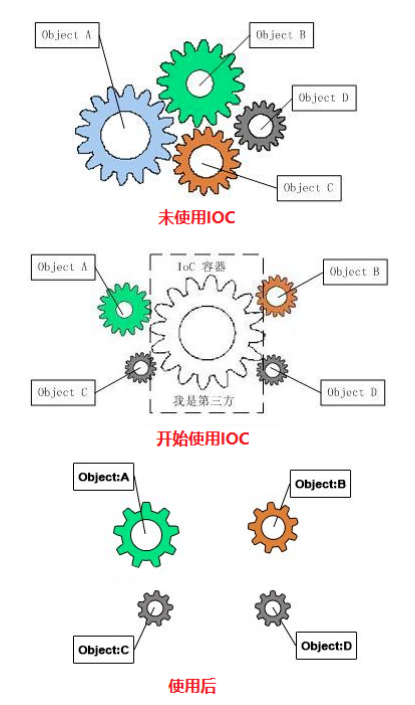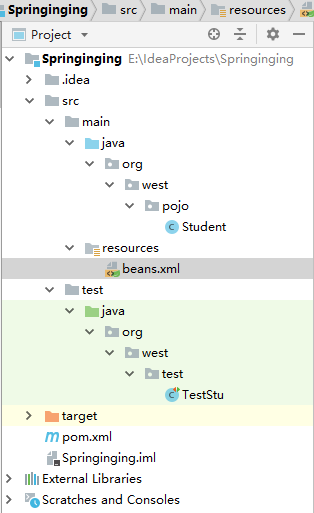目的:解决企业应用开发的复杂性
功能:使用基本的JavaBean代替EJB,并提供了更多的企业应用功能
范围:任何Java应用
Spring是一个轻量级控制反转(IoC)和面向切面(AOP)的容器框架。
我们使用原来的方式写一段代码测试:dao--service---前端
思考:现在前端传递或者调用不会变,所有操作都是我们程序猿来实现;
解决方案:前端操作,后台不变;留一个调用的接口
IOC的原型。
控制反转 (inversion of Control):IOC
他是一种设计思想。 根据这个思想有实现的方式,DI : 依赖注入。
本质就是设置接口 , set方法,是一种抽象思维
反转: 从被动到主动 , 程序猿主动控制 到 被动接受 , 由编写代码,编写接口,程序具有高度配置性和动态性;

项目的整体结构:

1.首先,我们用maven创建一个项目
导入Spring 的jar包
<dependency> <groupId>org.springframework</groupId> <artifactId>spring-webmvc</artifactId> <version>4.3.9.RELEASE</version> </dependency>
1 package org.west.pojo; 2 3 public class Student { 4 private String name; 5 private int age; 6 7 public Student() { 8 } 9 10 public Student(String name, int age) { 11 this.name = name; 12 this.age = age; 13 } 14 15 public String getName() { 16 return name; 17 } 18 19 public void setName(String name) { 20 this.name = name; 21 } 22 23 public int getAge() { 24 return age; 25 } 26 27 public void setAge(int age) { 28 this.age = age; 29 } 30 31 @Override 32 public String toString() { 33 return "Student{" + 34 "name='" + name + '\'' + 35 ", age=" + age + 36 '}'; 37 } 38 }
提供有参无参,get(),set(),toString()方法.
3.编写Spring的配置文件
<?xml version="1.0" encoding="UTF-8"?> <beans xmlns="http://www.springframework.org/schema/beans" xmlns:xsi="http://www.w3.org/2001/XMLSchema-instance" xsi:schemaLocation="http://www.springframework.org/schema/beans http://www.springframework.org/schema/beans/spring-beans.xsd"> <!--bean中id:所指的就是一个实体类的对象我们所起的名字 class:指的是我们需要实例化的类 property中的name 指的就是我们在实体类中对应的属性 value:指的是我们所设的值 --> <bean id="stu" class="org.west.pojo.Student"> <property name="name" value="猫猫"/> <property name="age" value="18"/> </bean> </beans>
package org.west.pojo; import org.junit.Test; import org.springframework.context.ApplicationContext; import org.springframework.context.support.ClassPathXmlApplicationContext; public class TestSpring { @Test public void test(){ //ClassPathXmlApplicationContext:参数 对应 Spring的核心配置文件 ApplicationContext context = new ClassPathXmlApplicationContext("ApplicationContext.xml"); //getBean:参数 对应我们bean中 给实例化类所起的名字 Student stu = (Student) context.getBean("stu"); System.out.println(stu); } }
思考问题?
-
student对象是由谁创建的?
-
student对象是由Spring创建的。
-
AppcationContext.xml ----> 管理bean,Java对象 , Spring就像一个容器,存放了许多的对象;
-
解析配置文件
-
通过反射创建对象并且设置值
-
-
-
student对象的属性是怎么设置值的?
-
student对象的属性是由Spring容器创建的。
-
这个过程就叫控制反转:IOC
控制:谁来控制对象的创建? 原来 :程序猿来控制, 使用Spring后,Spring来创建对象的
反转:程序本身不创建对象了,变成被动接受对象。
依赖注入:DI ,本质就是利用set方式来注入的。
IOC是一种编程思想。由主动的编程到被动的接受;
对象由Spring 来创建 , 管理 , 装配 !

